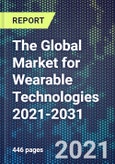Wearables are body-borne computational and sensory devices which can sense the person who wears them and/or their environment. Wearables can communicate either directly through embedded wireless connectivity or through another device (e.g. a smartphone). The data collected by the wearable device about the user or its environment is processed in a processing unit located locally or in an external server, and the results are ultimately provided to the wearer. Smart wearables may have control, communication, storage and actuation capabilities. The number and variety of wearable electronic devices have increased significantly in the past few years, as they offer significant enhancements to human comfort, health and well-being.Wearable and mobile health monitoring technologies are important due to the rapidly ageing global populations and the drastically increasing demand for in-home healthcare
There is increasing demand for wearable electronics from industries such as:
- Medical and healthcare monitoring and diagnostics
- Sportswear and fitness monitoring (bands)
- Consumer electronics such as smartwatches, smart glasses and headsets
- Military GPS trackers, equipment (helmets) and wearable robots
- Smart apparel and footwear in fashion and sport
- Workplace safety and manufacturing
Wearable and mobile health monitoring technologies are important due to the rapidly ageing global populations and the drastically increasing demand for in-home healthcare. Commercially available and near commercial wearable devices facilitate the transmission of biomedical informatics and personal health recording. Body-worn sensors, which can provide real-time continuous measurement of pertinent physiological parameters noninvasively and comfortably for extended periods of time, are of crucial importance for applications of mobile medicine.
Advancements over the last few years in electronics have also led to the development of electronic (E-textiles) or smart textiles. Smart textiles and garments can sense environmental stimuli and react or adapt in a predetermined way. This involves either embedding or integrating sensors/actuators ad electronic components into textiles for use in applications such as medical diagnostics and health monitoring, consumer electronics, safety instruments and automotive textiles.
Report contents include:
- In-depth market review of current products and technology development in Smartwatches, sports and fitness trackers, sleep trackers and wearable monitors, Smart glasses and head-mounted displays (VR, AR, MR, vision loss and eye trackers), military, industrial and workplace monitoring, flexible and stretchable electronics, e-textiles and smart clothing, artificial skin, skin patches, wearable health alert and monitoring devices, Continuous glucose monitoring (CGM), hydration and sweat sensors, wearable drug delivery, cosmetics patches, smart footwear, smart contact lenses, smart wound care, exoskeletons and hearables
- In-depth product assessment including products, producers, functionalities and prices
- Global market revenues, historical and forecast to 2032 for wearable electronics, medical wearables, electronic textiles and smart clothing and submarkets thereof
- Over 350 company profiles. Companies profiled include BeBop Sensors, dorsaVi Ltd, Enhanlabo Co., Ltd., Equivital Inc., FeelIT, HP1 Technologies Ltd., miomove s.r.o, Neosensory, Abbott Laboratories, Add Care Ltd., AerBetic, Inc., Avanix srl, Biobeat Technologies Ltd., biolinq Inc, CareWear, Cosinuss GmbH, Seventh Sense Biosystems, Cogwear, WearOptimo, Rombit, Rhaeos, Stryd, Neurava and many more
This product will be delivered within 1-3 business days.
Table of Contents
1 EXECUTIVE SUMMARY
2 THE WEARABLE CONSUMER ELECTRONICS MARKET
3 MEDICAL AND HEALTHCARE WEARABLES
4 ELECTRONIC TEXTILES (E-TEXTILES) AND SMART APPAREL
List of Tables
List of Figures
Companies Mentioned (Partial List)
A selection of companies mentioned in this report includes, but is not limited to:
- 3DEYES Co., Ltd.
- ABEye SA
- AerNos, Inc.
- Allterco Robotics
- AshChromics Corporation
- Asics
- Atheer, Inc.
- Avegant
- Bando Chemical Industries, Ltd.
- BeBop Sensors
- Bend Labs
- Boco, Inc.
- Bostonclub Co., Ltd.
- Brewer Science, Inc.
- C2 Sense, Inc.
- Cambridge Touch Technologies.
- Creact International Corporation
- CREAL SA
- Dispelix Oy
- dorsaVi Ltd.
- Ectosense
- Enhanlabo Co., Ltd.
- Epicore Biosystems Ltd.
- Epson
- Equivital
- Extriple Co, Ltd
- FeelIT
- Flexceed Co., Ltd.
- FlexEnable Ltd.
- Gait Up SA
- Hitachi Ltd.
- Holst Centre
- Hoya Digital Solutions Corp.
- HP1 Technologies
- Innovega, Inc.
- Iristick
- Kinetic
- Kwant.ai
- Litho
- Magic Leap, Inc.
- miomove s.r.o.
- Mithras Technology AG
- Molex
- Nano Engineered Applications, Inc.
- Nanusens
- Neosensory
- NextVPU (Shanghai) Co., Ltd.
- Nippon Mektron, Ltd.
- Nippon Paper Group
- Novasentis
- OrCam Technologies Ltd.
- Osaka Organic Chemical Industry Ltd.
- Oxsight Ltd.
- Pie Crystal Co., Ltd.
- RealWear
- Rokid.
- Sekisui Polymatech
- Sequent AG
- Shenzhen Grahope New Materials Technologies Inc.
- Somalytics
- suitX
- Sun Corporation
- Tacterion GmbH
- Taiwan Alpha Electronic Co., Ltd.
- Tobii Technology KK
- Triax Technologies
- Wearable Devices Ltd.
- Wiliot
- Withings SA
- Yamaha Motor Co., Ltd.
- Zhuhai AdvanPro Technology Co., Ltd.
Methodology

LOADING...








